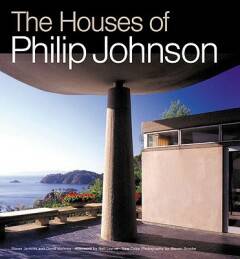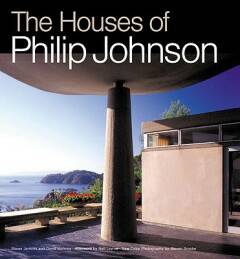
Je cadeautjes zeker op tijd in huis hebben voor de feestdagen? Kom langs in onze winkels en vind het perfecte geschenk!
- Afhalen na 1 uur in een winkel met voorraad
- Gratis thuislevering in België vanaf € 30
- Ruim aanbod met 7 miljoen producten
Je cadeautjes zeker op tijd in huis hebben voor de feestdagen? Kom langs in onze winkels en vind het perfecte geschenk!
- Afhalen na 1 uur in een winkel met voorraad
- Gratis thuislevering in België vanaf € 30
- Ruim aanbod met 7 miljoen producten
Zoeken
€ 75,45
+ 150 punten
Omschrijving
For almost three-quarters of a century, as a critic and curator beginning in 1930s, and as a practicing architect since the 1940s, Philip Johnson has been at the center of modern architecture's development. His celebrated Glass House, built in 1949 in New Canaan, Connecticut -- a crystallization of Johnson's commitment to the high modernism of his mentor Mies van der Rohe -- is perhaps the single most famous house of the twentieth century. Until now, however, that house has not been looked at in the context of Johnson's many other house projects. This book, the first to comprehensively survey Johnson's residential work, not only brings to light a largely neglected side of Johnson's achievement, but freshly illuminates his entire career.
By examining all of Johnson's houses, authors Stover Jenkins and David Mohney, both architects, help us understand the Glass House as an expression of Johnson's developing thought. Focusing first on Johnson's student work at Harvard and his early commissions, they show how the Glass House reflects Johnson's concentrated study not only of pioneering modern architects including Frank Lloyd Wright and Le Corbusier, but of masters of previous centuries such as Claude-Nicolas Ledoux and Karl Friedrich Schinkel. They detail the three-year design process of the Glass House, and then show how Johnson moved beyond the influence of Mies to create a remarkably diverse body of work -- one that is nevertheless unified by characteristic themes, like Johnson's inventive development of the Miesian court-house scheme, and his articulation of space by the use of connected pavilions.
Johnson's clients have always included powerful patrons of art and architecture. Presented in this book are his jewel-like townhouse for Blanchette Rockefeller and the Houston home of John and Dominique de Menil, with its enclosed court; projects for collector Joseph Hirshhorn; and the spectacular vacation house at Cap Bénat for the Biossonnas family. Recent projects include a sprawling desert compound in Israel and a village-like vacation residence in the Caribbean. But from the beginning, when Johnson submitted a house he built for himself in Cambridge, Massachusetts, as his graduate thesis, he has been his own most effective client. The book concludes with a look at the ten built and seven unbuilt projects he has designed over the years for the New Canaan estate. As an afterword, the book includes a penetrating essay by architectural historian Neil Levine, who argues that we must now recognize Johnson's publication of the Glass House, in a 1950 article, as a turning point in the recognition of modernism as a historical movement.
Supporting a critical account of approximately thirty built and forty unbuilt projects, the book includes numerous plans and drawings, many never before published, and historical photographs. New color photographs by Steven Brooke capture the ways Johnson has used light, space, and landscape to create some of modernism's most appealing houses. Essential reading for architects and students, this book is also a vital resource for the study of one of modern architecture's most influential figures.
By examining all of Johnson's houses, authors Stover Jenkins and David Mohney, both architects, help us understand the Glass House as an expression of Johnson's developing thought. Focusing first on Johnson's student work at Harvard and his early commissions, they show how the Glass House reflects Johnson's concentrated study not only of pioneering modern architects including Frank Lloyd Wright and Le Corbusier, but of masters of previous centuries such as Claude-Nicolas Ledoux and Karl Friedrich Schinkel. They detail the three-year design process of the Glass House, and then show how Johnson moved beyond the influence of Mies to create a remarkably diverse body of work -- one that is nevertheless unified by characteristic themes, like Johnson's inventive development of the Miesian court-house scheme, and his articulation of space by the use of connected pavilions.
Johnson's clients have always included powerful patrons of art and architecture. Presented in this book are his jewel-like townhouse for Blanchette Rockefeller and the Houston home of John and Dominique de Menil, with its enclosed court; projects for collector Joseph Hirshhorn; and the spectacular vacation house at Cap Bénat for the Biossonnas family. Recent projects include a sprawling desert compound in Israel and a village-like vacation residence in the Caribbean. But from the beginning, when Johnson submitted a house he built for himself in Cambridge, Massachusetts, as his graduate thesis, he has been his own most effective client. The book concludes with a look at the ten built and seven unbuilt projects he has designed over the years for the New Canaan estate. As an afterword, the book includes a penetrating essay by architectural historian Neil Levine, who argues that we must now recognize Johnson's publication of the Glass House, in a 1950 article, as a turning point in the recognition of modernism as a historical movement.
Supporting a critical account of approximately thirty built and forty unbuilt projects, the book includes numerous plans and drawings, many never before published, and historical photographs. New color photographs by Steven Brooke capture the ways Johnson has used light, space, and landscape to create some of modernism's most appealing houses. Essential reading for architects and students, this book is also a vital resource for the study of one of modern architecture's most influential figures.
Specificaties
Betrokkenen
- Auteur(s):
- Uitgeverij:
Inhoud
- Aantal bladzijden:
- 288
- Taal:
- Engels
Eigenschappen
- Productcode (EAN):
- 9780789201140
- Verschijningsdatum:
- 1/09/2001
- Uitvoering:
- Hardcover
- Formaat:
- Genaaid
- Afmetingen:
- 262 mm x 285 mm
- Gewicht:
- 2059 g

Alleen bij Standaard Boekhandel
+ 150 punten op je klantenkaart van Standaard Boekhandel
Beoordelingen
We publiceren alleen reviews die voldoen aan de voorwaarden voor reviews. Bekijk onze voorwaarden voor reviews.









